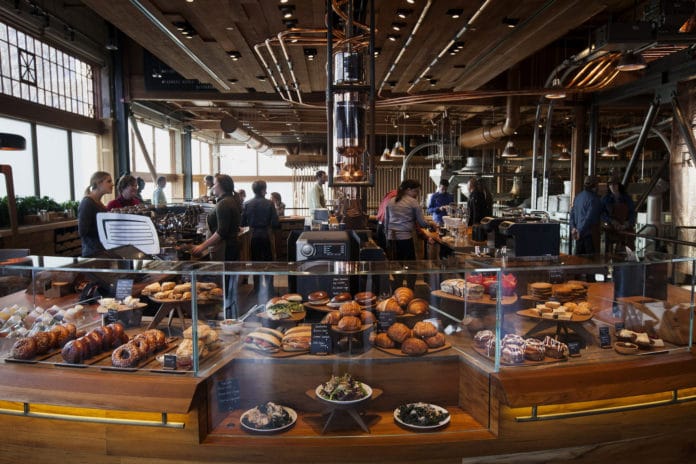For years now, Starbucks has been dipping a toe into more luxe offerings: In 2014, it opened a sprawling Roastery in Seattle where customers can drink small-batch coffee in a tasting-room-like environment. Several years earlier, it added its premium line of Reserve coffees, rare blends available for only limited-time runs.
Now, these upscale concepts have gone from an intriguing experiment to a cornerstone of the coffee empire’s strategy: The company said recently that it will open 20 to 30 Roasteries across the globe, with Shanghai and New York locations coming soon. And its Reserve brand is being parlayed into a cafe concept, with stores that are about double the size of a traditional Starbucks. These outposts have price tags as high as $10 for certain types of coffee beverages, and will also serve alcoholic drinks.
The company made clear how serious it was about these new brands when it announced Dec. 1 that its chief executive, Howard Schultz, would step down from that role next year to focus on building out the Roastery and Reserve portfolio. And in a Wednesday presentation for investors, executives offered more details on how they envision these concepts buffeting the broader business.
The idea is that the Roastery and Reserve stores are much more of an experience than your typical Starbucks store. They’re not just a quick stop you make on your way into the office; they’re not just a drive-thru spot you roll through when your kid falls asleep in the car seat. In theory, they’re a destination, and that’s a distinction Schultz believes is critical in a country that he and other industry executives have said is “over-retailed” — meaning there are too many stores.
“In a world where people are spending much more time on their phones, on their desktop, on their iPad, people are longing for more human connection,” Schultz said.
The Roasteries and Reserve stores are a way for Starbucks to try to tap into that, to try to grab a piece of the money that you spend on social experiences such as cooking classes or wine tastings or distillery tours. That’s why he said Wednesday the Seattle Roastery has “a lot more theater, a lot more romance” than what we’re used to from the Starbucks chain.
These new concepts will also take a somewhat different approach to food than typical Starbucks locations. They will bake fresh pastries and breads on site. That will require them to have dedicated staffers who just focus on those dishes, meaning the familiar baristas will work alongside a team of food preparers. And the New York Roastery, for example, will feature a 45-foot bar where customers can have cocktails, beer and wine, a bid to make these restaurants into evening hangout spots, not just gathering places for morning or afternoon pick-me-ups.
So does this mean you can expect a slowdown in new openings of traditional Starbucks stores? Not even close. The company plans to open 12,000 more of those by 2021, with about half of those locations coming in its largest markets, the United States and China. But even in your stalwart neighborhood Starbucks store, you might notice hints of this new strategy. Over the next five years, it plans to add “Reserve Bars” to 20 percent of its regular restaurants, injecting those locations with some of the fanciness associated with the Reserve brand.
Executives sought to assure investors that its ramp up of the Roastery and Reserve concepts was not a reflection of wavering confidence in the old-school Starbucks brand.
“There’s no issue in the core business. We’re merchants. We have to be creative, we have to be innovative,” Schultz said.
That mindset might also explain why the company is moving forward with plans to open standalone stores in the U.S. of an Italian bakery called Princi. Starbucks had revealed earlier this year that it had invested in this Milan-based purveyor of artisanal pizzas and breads. (Princi’s foccacias, loaf cakes and other goods will also be sold in Roasteries and Reserve stores.)
Starbucks discussed its vision for its new brands as part of the unveiling its five-year financial forecasts. The company said it expects that it will deliver 10 percent growth in revenue and a 15 to 20 percent increase in earnings per share. Comparable sales, a measure of sales at restaurants open more than a year, are projected to rise “mid-single digits.”






